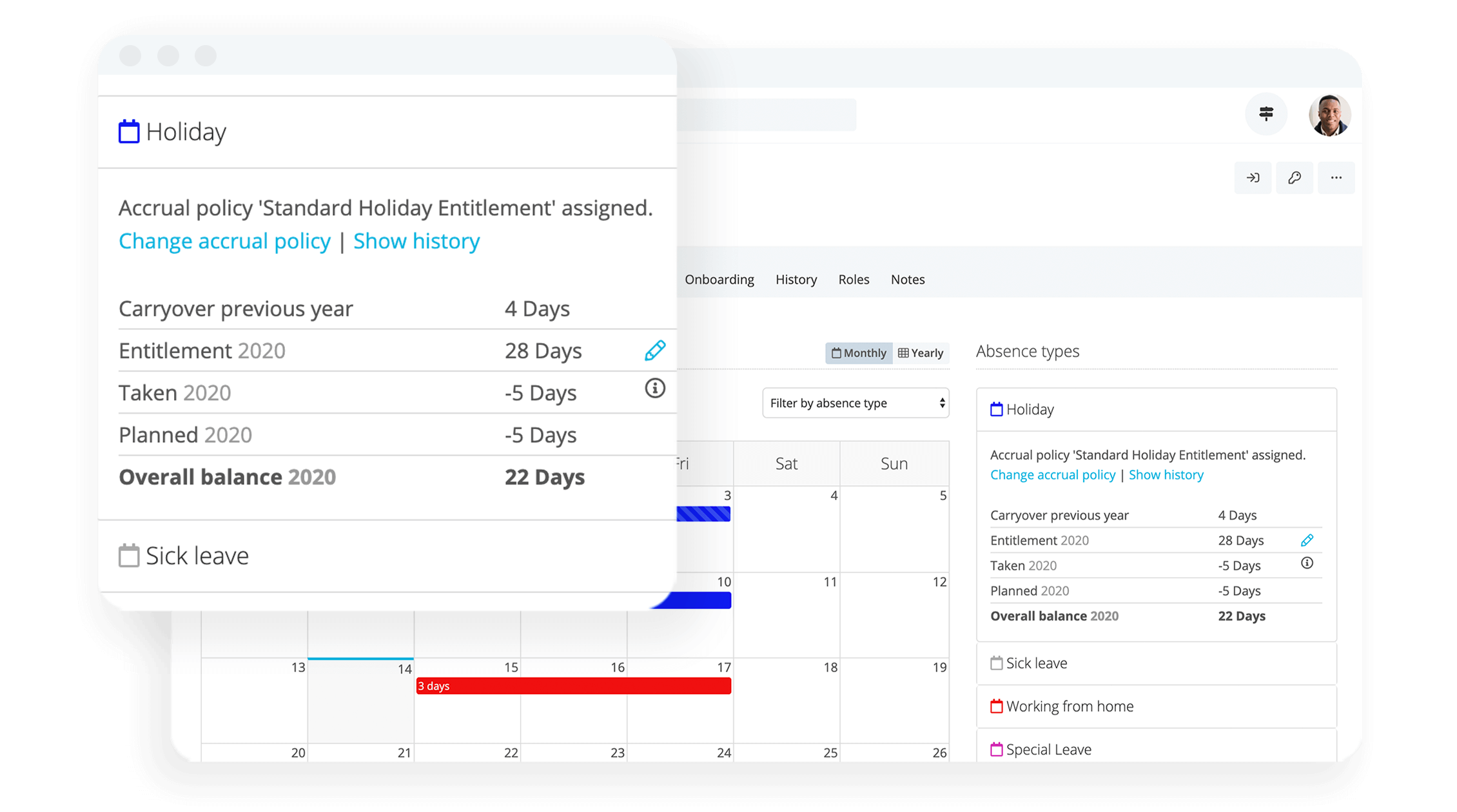How is your organization currently allowing employees to make flexible working requests? In our most recent HR study, 38% of employees in the UK are looking to change roles in the next 6 to 12 months, and part of this could be due to flexible working, and how different organizations are approaching their back-to-office plans.
Let’s dig into the topic of flexible working requests, with some examples, ideas, and ways your HR or People team can manage flexible or hybrid work in the best way possible.
Manage your entire workforce from one place: Personio.
Contents
What Is Flexible Working?
What Is A Flexible Working Request?
What Are The Benefits of Flex Work?
How Can HR Lead When It Comes To Flexible Working?
What Are The Downsides of Flexible Working?
What Is A Flexible Working Request?
If an employee believes that they may be more productive, or generally happier, with a change in their working routine, they have the right to make a flexible working request. Prior to the Covid-19 pandemic, these may have been rare and on more of a case-by-case basis, but studies show that now around 1 in 4 workers plan to be fully remote in the near future.
What Is Flexible Working?
Flexible working is work that ‘flexes’ to the needs of employees. Typically, this takes the form of either flex hours or flexible work locations. For most companies, the concept of flexible working can be best understood as an alternative to the very traditional corporate culture of working 9 to 5, in an office, amongst similar standards.
What Are Flexible Working Types Or Examples?
Some of the most common request times for flexible working, as per the acas, are:
- Changing the time you both start and finish your workday.
- Perform the same amount of hours in a shorter week (40 hours over four days, for example).
- Working from home or in another location.
- Job sharing or sharing responsibilities in a more thorough fashion.
These are just some flexible working examples, but if we think about this type of work very holistically, it is essentially any way that an employer can help an employee perform better in their role outside of the traditional framework of work.
Click here for the thought process behind Personio’s own brand of flexible work: PersonioFlex.
What Does UK Law Say About Flexible Working Requests?
If an employee is legally an employee of an organization, then they are allowed to make a flexible working request after 26 weeks of employment. In turn, an employer must review that case, act objectively, and offer a verdict within three months of receiving the request.
As an employer, you may be able to reject this request, but it needs to be with cause. It also needs to be for purely business reasons (if, for good reason, the business would suffer as a result of this request). Flexible working requests cannot be denied based on discriminatory grounds.
Can Parents Make A Flexible Working Request?
Definitely! Whether you are a working parent, a caregiver, or returning from maternity leave, every employee (within the 26-weeks rule) has the right to make a flexible working request.
Why Should Your Org Accept Flexible Working Requests?
Alternative work patterns are on the rise, thanks in part to flexible working rights in countries like the UK. In Europe, between 50 and 90 per cent of employees can now take advantage of these working practices.
In the U.S., nearly 30 per cent of employed Americans have the option to work at least partly from home. The numbers keep rising, and with good reason.
Myriads of studies show the benefits of flexible working for companies and employees:
- Organizations gain access to a larger talent pool when they can hire people in other locations.
- A flexible working policy can even lower overhead costs by reducing office space sizes and utility costs.
- Employees can save time, reduce transportation and child care costs, and work when they are most efficient.
- There is often greater employee engagement, increased productivity, and less absenteeism and turnover.
Track Flexible Working Requests From Personio
Personio allows you to track various types of absence and work modes across your organization, including allowing employees to make flexible working requests. Click below to learn more.
How Can HR Lead When It Comes To Flexible Working Requests?
When it comes to flexible working, it is up to HR to provide the right structure and framework to make it efficient and successful for everyone. One of the ways they can do this is throuhg HR software, which can ensure that operational excellence is ensured (and flexible work can be handled strategically).
From advocating for a flex policy through to creating the structures around it, HR plays a leading role in the success of flexible work arrangements. Setting up these practices is a multi-step process and it will differ for each organization. Here’s a roundup of best practices we’d recommend:
1. Perform A Needs Assessment
Start with an organizational assessment to see where things stand. Especially when it comes to a back-to-the-office policy or a phased return to work, it helps to take the temperature of your organization.
To see where people stand, ask them questions in an employee pulse survey. Consider questions like: \
- How many days, on average, would you want to work in the office?
- Do you want to work in an office environment at all?
- Would you be interested in a compressed hours schedule (regular hours over four days versus five)?
- Would you appreciate a flexible working request framework or policy to be made easily available?
Depending on the size and culture of your company, questions and employee surveys like these can really help uncover how people feel, what they would prefer, and what is going to be best for business. So, this is the perfect place to start.
2. Define A Flexible Working Policy
Regardless of how your organization feels, you need to provide clarity to every worker. That means having a flexible working policy and process, to provide clear guidelines on and procedures for how these arrangements ‘work.’
For example, you should consider stating:
- If jobs with flexible hours will apply to all staff.
- If employees who want this benefit need to submit a flexible working request.
And, of course, HR needs to ensure that the policy is in compliance with UK employment law.
3. Train Your Managers
Managing flexible workers or managing remote teams is crucial to the success of a policy. But it’s different than managing people in a traditional work setting. Arrange training for managers on topics like:
- Overseeing remote staff
- Managing virtual teams
- Evaluating the performance of remote employees
Give your managers and leads the opportunity to be just as successful with flexible work. After all, it is definitely going to have an effect on the way they work, and how productive they feel, so HR should be there to fully support them, too.
4. Implement A Tracking Tool
The perception of fairness is sometimes a concern with flexible working policies. H
ow can organizations ensure that home-based, part-time or employees with flexible working hours are really doing their jobs? By making attendance tracking easy and accessible, that’s how.
Provide a self-service tool that lets employees log their attendance and absences, and lets managers keep track of this data. This will not only empower employees to track their time, but will result in accurate HR reporting and analytics.
5. Establish Communication Tools and Working Norms
The Covid-19 pandemic has revealed the necessity for communication tools, like Slack or Zoom. So, first off, ensure that everyone has access to team collaboration software for instant messaging, remote conferencing, project management, and document sharing.
As HR managers (and flex employees too), make sure you also have an accessible tool to keep track of employee data. It’s also good to encourage managers to set up communication rules, such as daily or weekly “check-ins” with individual employees, and monthly team meetings (virtual or in-person).
This helps keeps everyone in touch, on point and accountable.
6. Raise Awareness
Finally, HR needs to raise awareness among staff of their right to request flexible working hours or location, and the advantages that this policy brings. You should also highlight this benefit as part of your employer branding strategy and employer value proposition.
What Are The Downsides of Flexible Working?
It is quite clear that the businesses of the future need to have flexible working in place. For many organizations emerging from the pandemic, it is simply table stakes. But, the downsides are finding the time for HR to manage flexible work, flex employees, and flexible working requests.
So, the main downside of all this is the lack of time. But, when HR has a solution in place, like an HR system, it can afford them the time to truly focus on flexible working as a business topic and objective!
Find Time For
Strategic HR






